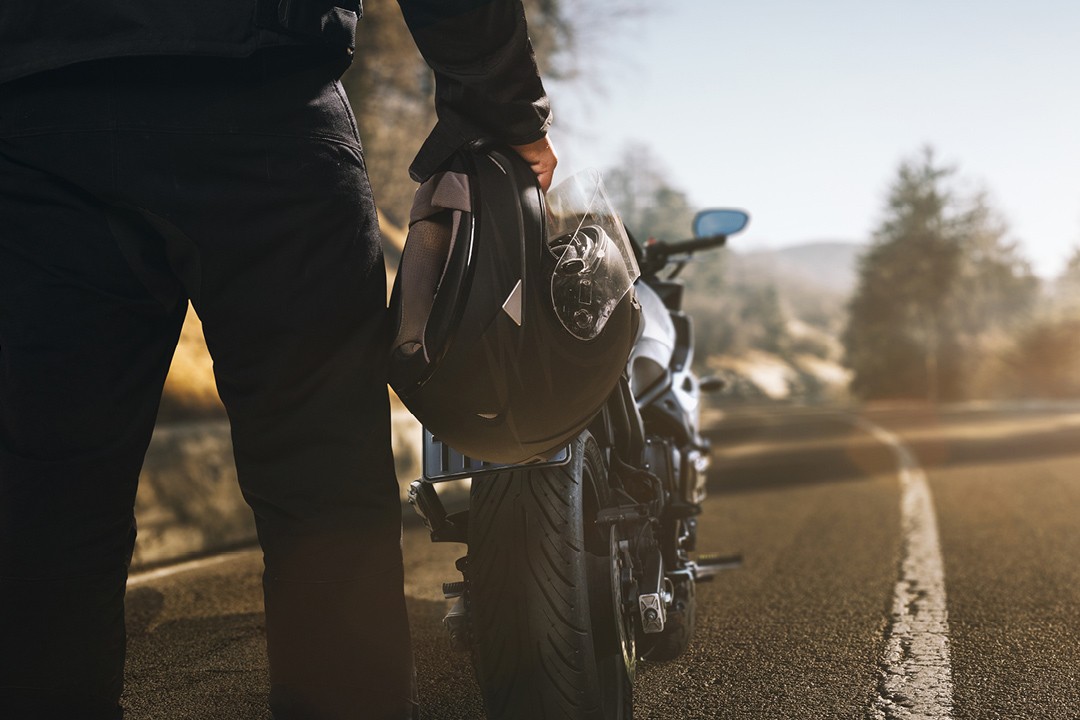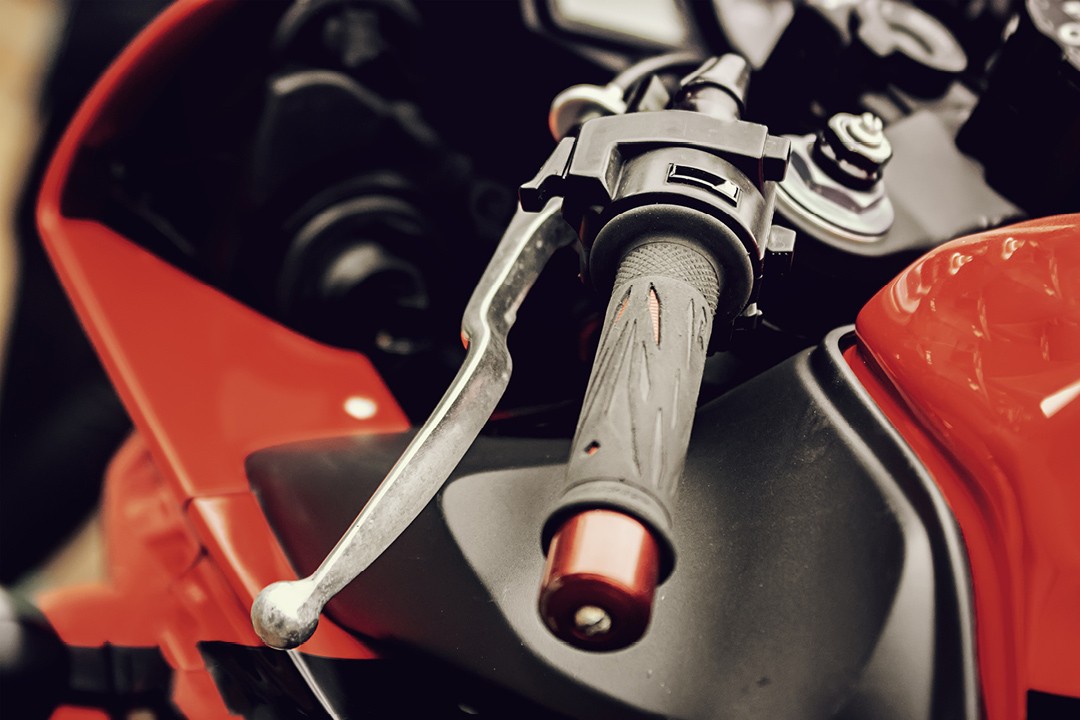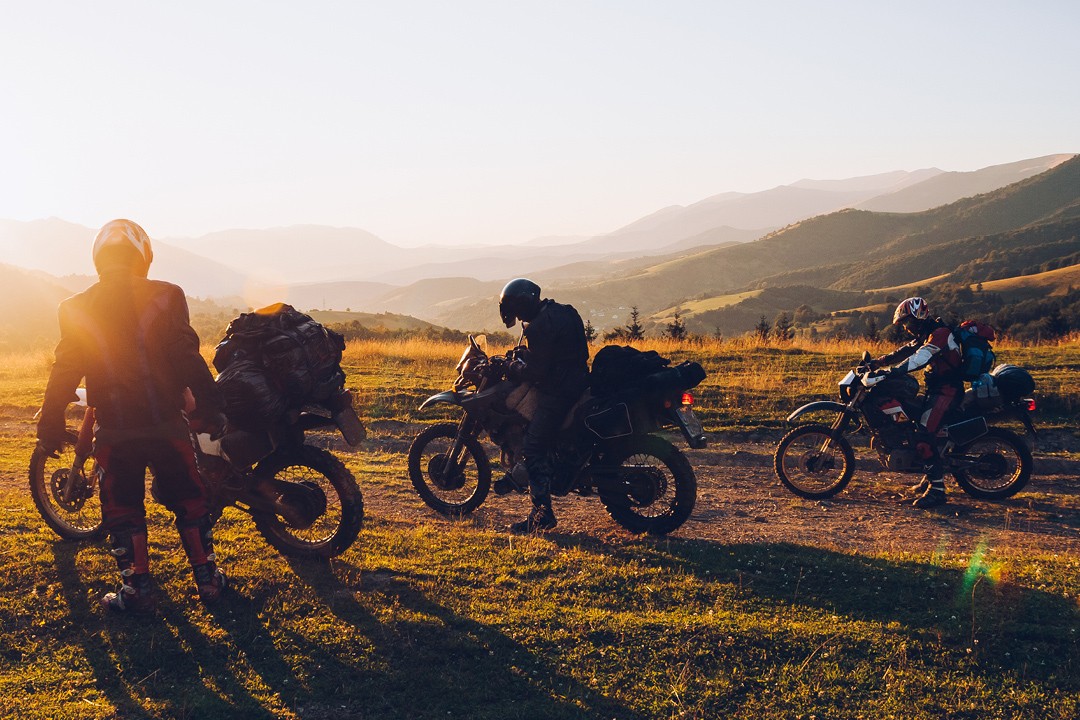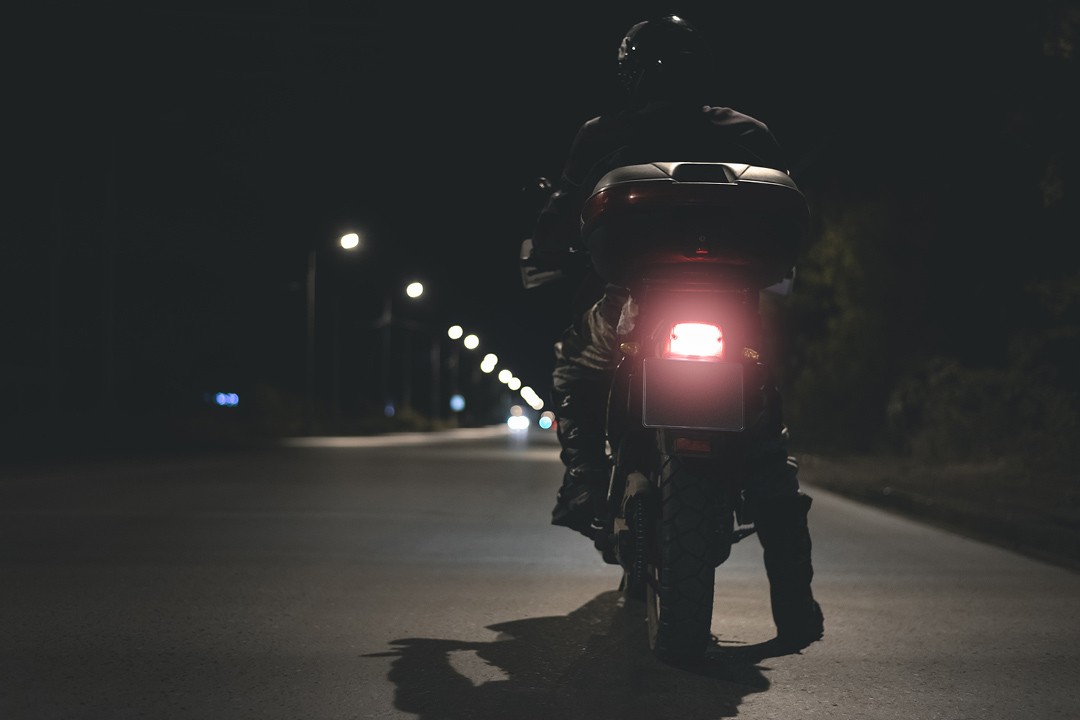Is It Hard To Learn How To Ride A Motorcycle? Discover the truth about learning to ride a motorcycle, exploring the steps, safety measures, and resources available at LEARNS.EDU.VN to make your learning journey smooth and enjoyable. Mastering motorcycle riding involves understanding the controls, practicing balance, and developing road awareness, all of which LEARNS.EDU.VN can help you achieve. Dive into our expert-backed advice and start your journey towards becoming a skilled rider, exploring the techniques and considerations, including rider training courses.
1. Gearing Up for the Ride: The Foundation of Motorcycle Mastery
Before you even think about starting the engine, the most crucial step is preparing with the right gear. Motorcycling, while exhilarating, comes with inherent risks. Minimizing these risks begins with wearing the appropriate protective equipment. This gear acts as your first line of defense, significantly reducing the potential for injury in case of an accident.
-
Helmet: A high-quality, well-fitting helmet is non-negotiable. It protects your head, the most vulnerable part of your body, in the event of a crash. Look for helmets certified by DOT (Department of Transportation), ECE (Economic Commission for Europe), or Snell, ensuring they meet stringent safety standards.
-
Jacket and Pants: Opt for motorcycle-specific jackets and pants made from abrasion-resistant materials like leather, Kevlar, or reinforced textiles. These materials provide a protective layer against scrapes and impacts. Integrated armor in the shoulders, elbows, and knees offers additional safety.
-
Gloves: Your hands are essential for controlling the motorcycle. Motorcycle gloves protect them from abrasions, impacts, and the elements. Look for gloves with reinforced palms and knuckle protection.
-
Boots: Sturdy boots that cover your ankles are a must. They provide ankle support, protect your feet from impacts, and prevent burns from the exhaust.
| Gear | Purpose | Key Features |
|---|---|---|
| Helmet | Head protection | DOT, ECE, or Snell certification, proper fit |
| Jacket/Pants | Abrasion and impact resistance | Leather, Kevlar, reinforced textiles, integrated armor |
| Gloves | Hand protection | Reinforced palms, knuckle protection |
| Boots | Ankle and foot protection | Ankle support, impact protection, heat resistance |





Equipping yourself with the right gear is an investment in your safety and peace of mind. Always prioritize quality and fit when selecting your motorcycle apparel.
2. Selecting the Right Motorcycle: A Beginner’s Guide to Finding the Perfect Fit
Choosing your first motorcycle is a pivotal decision that can significantly impact your learning experience. The ideal beginner bike should be manageable, forgiving, and inspire confidence. Here’s what to consider when selecting your first motorcycle:
-
Weight and Power: Opt for a lighter motorcycle with a manageable power output. A bike that’s too heavy or powerful can be intimidating and difficult to control, especially for a beginner. Look for motorcycles in the 250-650cc range.
-
Seat Height: Ensure you can comfortably place both feet on the ground while seated on the motorcycle. This allows for better balance and control, particularly when starting, stopping, and maneuvering at low speeds.
-
Ergonomics: Choose a motorcycle with a comfortable riding position. An upright posture is generally recommended for beginners, as it provides better visibility and control.
-
Motorcycle Type:
- Standard/Naked Bikes: These offer a balanced riding position and are often lighter and more agile, making them ideal for beginners.
- Cruisers: While stylish, cruisers can be heavier and less maneuverable than other types of motorcycles. However, some smaller cruisers can be suitable for beginners.
- Dual-Sport Bikes: These versatile bikes can handle both on-road and off-road riding. Their upright riding position and manageable power make them a good option for beginners.
-
Test Ride: Whenever possible, test ride a motorcycle before making a purchase. This allows you to assess its comfort, handling, and overall suitability.
| Feature | Importance | Recommendation |
|---|---|---|
| Weight/Power | Manageability and control | Lighter weight, 250-650cc range |
| Seat Height | Balance and stability | Ability to comfortably place both feet on the ground |
| Ergonomics | Comfort and control | Upright riding position |
| Motorcycle Type | Suitability for beginners | Standard/Naked, Cruiser (smaller models), Dual-Sport |
Remember, your first motorcycle is a stepping stone. As your skills and confidence grow, you can always upgrade to a larger, more powerful machine.
3. Mastering the Brakes: Your First Line of Defense on Two Wheels
Before you even start the engine, understanding and mastering the brakes is paramount. The brakes are your primary means of controlling your speed and stopping safely. Here’s what you need to know about motorcycle brakes:
-
Front Brake: Located on the right handlebar, the front brake provides the majority of your stopping power (approximately 70%). It’s crucial to use the front brake smoothly and progressively to avoid locking up the front wheel.
-
Rear Brake: Located on the right foot pedal, the rear brake provides additional stopping power and helps stabilize the motorcycle. Use the rear brake in conjunction with the front brake for optimal stopping performance.
-
Coordination: The key to effective braking is coordinating the front and rear brakes. Apply both brakes simultaneously, using a slightly greater emphasis on the front brake.
-
Practice: Practice braking in a controlled environment, such as an empty parking lot. Start by applying light pressure to both brakes and gradually increase the pressure until you come to a complete stop.
-
ABS (Anti-lock Braking System): If possible, choose a motorcycle equipped with ABS. ABS prevents the wheels from locking up during braking, allowing you to maintain control and steer around obstacles.
| Brake Type | Location | Function | Usage |
|---|---|---|---|
| Front | Right handlebar | Primary stopping power | Smooth, progressive application, avoid locking the wheel |
| Rear | Right foot pedal | Additional stopping power, stabilization | Use in conjunction with front brake, avoid locking the wheel |
| ABS | Integrated system | Prevents wheel lockup during braking | Allows for controlled braking and steering in emergency situations |
Mastering the brakes is a fundamental skill that can save your life. Practice regularly and develop a feel for how much pressure to apply in different situations.
4. Clutch and Throttle: The Dance of Control and Acceleration
The clutch and throttle are the heart of motorcycle control, working in harmony to manage power and speed. Mastering these controls is essential for smooth starts, precise maneuvers, and confident riding.
-
Clutch: Located on the left handlebar, the clutch disengages the engine from the transmission, allowing you to shift gears and prevent stalling.
-
Throttle: Located on the right handlebar, the throttle controls the amount of fuel delivered to the engine, regulating your speed and acceleration.
-
Coordination: The key to smooth starts and gear changes is coordinating the clutch and throttle.
- Starting: Pull the clutch lever in fully, engage first gear, and gently roll on the throttle while gradually releasing the clutch lever.
- Shifting: Pull the clutch lever in fully, ease off the throttle, shift to the next gear, and gently roll on the throttle while gradually releasing the clutch lever.
-
Practice: Practice starting, stopping, and shifting gears in a controlled environment. Focus on smooth, coordinated movements to avoid jerky starts and stalls.
| Control | Location | Function | Usage |
|---|---|---|---|
| Clutch | Left handlebar | Disengages engine from transmission | Smooth starts, gear changes, prevents stalling |
| Throttle | Right handlebar | Controls fuel delivery, regulates speed/acceleration | Smooth acceleration, maintains speed, controls engine RPM |
Mastering the clutch and throttle takes time and practice. Be patient with yourself, and focus on developing a smooth, coordinated technique.
5. The Art of Turning: Leaning into Confidence
Turning is a fundamental skill that requires a combination of technique, balance, and confidence. Here’s how to master the art of turning on a motorcycle:
-
Countersteering: At higher speeds, motorcycles are steered by countersteering. To turn right, gently push the right handlebar forward; to turn left, gently push the left handlebar forward. This may seem counterintuitive, but it’s the natural way motorcycles steer.
-
Leaning: As you turn, lean your body in the same direction as the motorcycle. This helps maintain balance and stability.
-
Looking Through the Turn: Always look through the turn to where you want to go. This helps you maintain your balance and steer the motorcycle in the correct direction.
-
Throttle Control: Maintain a steady throttle throughout the turn. This helps stabilize the motorcycle and prevent sudden changes in speed.
-
Practice: Practice turning in a controlled environment, such as an empty parking lot. Start with gentle turns and gradually increase the lean angle as your confidence grows.
| Technique | Description | Purpose |
|---|---|---|
| Countersteering | Gently pushing the handlebar in the opposite direction | Initiates the turn, helps maintain balance at higher speeds |
| Leaning | Leaning your body in the same direction as the bike | Maintains balance, helps the bike follow the turn |
| Looking Through Turn | Focusing your gaze on the desired path | Improves balance, guides the bike in the correct direction |
| Throttle Control | Maintaining a steady throttle | Stabilizes the bike, prevents sudden changes in speed |
Turning is a skill that requires practice and confidence. Start slowly, focus on your technique, and gradually increase your lean angle as you become more comfortable.
6. The Power of Practice: Building Skills and Confidence on the Road
Once you’ve mastered the basics, the key to becoming a skilled and confident rider is practice, practice, practice. Here’s how to make the most of your practice sessions:
-
Start Slow: Begin with short rides on quiet, familiar roads. Gradually increase the length and complexity of your rides as your skills and confidence grow.
-
Focus on Fundamentals: Dedicate each practice session to honing specific skills, such as braking, turning, or shifting gears.
-
Vary Your Routes: Ride on different types of roads and in different traffic conditions to gain experience and adaptability.
-
Ride with Experienced Riders: Riding with experienced riders can provide valuable learning opportunities and help you identify areas for improvement.
-
Take Advanced Training Courses: Consider taking advanced training courses to further develop your skills and learn advanced riding techniques.
| Practice Element | Description | Benefit |
|---|---|---|
| Start Slow | Begin with short, easy rides | Builds confidence, avoids overwhelming new riders |
| Focus on Fundamentals | Dedicate sessions to specific skills | Improves technique, reinforces essential skills |
| Vary Routes | Ride different roads/conditions | Increases adaptability, broadens riding experience |
| Ride with Experienced | Learn from seasoned riders | Provides valuable insights, identifies areas for improvement |
| Advanced Training | Enroll in advanced riding courses | Develops advanced skills, enhances safety knowledge |
Practice is the cornerstone of motorcycle mastery. The more you ride, the more comfortable and confident you’ll become, and the more you’ll enjoy the freedom and exhilaration of motorcycling.
7. Time Investment: How Long Does It Take to Master Motorcycle Riding?
There’s no one-size-fits-all answer to how long it takes to learn to ride a motorcycle. Factors such as natural aptitude, prior experience (e.g., bicycle riding), and the frequency and quality of practice all play a role.
-
Basic Skills: Most people can learn the basic skills of motorcycle riding, such as starting, stopping, shifting, and turning, within a few days or weeks of consistent practice.
-
Confidence and Competence: Building confidence and competence takes time and experience. It may take several months or even years to become a truly skilled and confident rider.
-
Continuous Learning: Motorcycle riding is a continuous learning process. There’s always something new to learn, whether it’s advanced riding techniques, mechanical maintenance, or navigating different road conditions.
| Skill Level | Time Investment | Focus |
|---|---|---|
| Basic Skills | Days to Weeks | Starting, stopping, shifting, turning |
| Confidence/Competence | Months to Years | Mastering techniques, adapting to conditions, building experience |
| Continuous Learning | Ongoing | Advanced techniques, maintenance, safety, new road conditions |
The journey to motorcycle mastery is a marathon, not a sprint. Be patient with yourself, enjoy the process, and never stop learning.
8. Formal Training vs. Self-Teaching: Choosing the Right Learning Path
When it comes to learning how to ride a motorcycle, you have two primary options: formal training courses and self-teaching. While self-teaching may seem appealing, formal training offers significant advantages in terms of safety, structure, and expertise.
-
Formal Training Courses: These courses, such as those offered by the Motorcycle Safety Foundation (MSF), provide a structured curriculum, qualified instructors, and a safe, controlled learning environment.
- Benefits:
- Learn essential skills from qualified instructors
- Practice in a safe, controlled environment
- Receive feedback and guidance
- Increase your chances of passing the motorcycle license test
- Benefits:
-
Self-Teaching: This involves learning from friends or family members, or simply trying to figure things out on your own.
- Risks:
- Developing bad habits
- Increased risk of accidents
- Lack of structured learning
- Potential for injury
- Risks:
| Learning Method | Advantages | Disadvantages | Recommendation |
|---|---|---|---|
| Formal Training | Structured learning, qualified instructors, safety | Cost, time commitment | Highly recommended for beginners, enhances safety and skill development |
| Self-Teaching | Cost-effective, flexible | Risk of bad habits, increased accident risk, lack of structure | Not recommended for beginners, can supplement formal training with practice |
Formal training courses are the safest and most effective way to learn how to ride a motorcycle. They provide you with the essential skills, knowledge, and confidence to ride safely and responsibly. LEARNS.EDU.VN offers connections to certified instructors and resources to find the right course for you.
9. The Essence of Safe Riding: Prioritizing Safety on Every Journey
Motorcycle riding is inherently more risky than driving a car, so prioritizing safety is paramount. Here are some essential safety tips to keep in mind:
-
Wear Protective Gear: Always wear a helmet, jacket, pants, gloves, and boots.
-
Be Visible: Wear bright clothing and use reflective tape to increase your visibility to other drivers.
-
Ride Defensively: Assume that other drivers don’t see you and be prepared to react to their mistakes.
-
Maintain a Safe Following Distance: Give yourself plenty of room to stop in case of an emergency.
-
Be Aware of Road Hazards: Watch out for potholes, gravel, and other road hazards.
-
Avoid Riding Impaired: Never ride under the influence of alcohol or drugs.
| Safety Aspect | Recommendation | Purpose |
|---|---|---|
| Protective Gear | Always wear full gear | Minimizes injury in case of an accident |
| Visibility | Wear bright clothing, use reflective tape | Increases visibility to other drivers |
| Defensive Riding | Assume other drivers don’t see you | Allows for proactive reaction to potential hazards |
| Following Distance | Maintain safe distance from other vehicles | Provides ample time to react and stop safely |
| Road Hazard Awareness | Watch for potholes, gravel, etc. | Avoids accidents caused by road imperfections |
| Impairment Avoidance | Never ride under the influence | Ensures clear judgment and control |
Safe riding is a mindset. By following these tips and always prioritizing safety, you can significantly reduce your risk of accidents and enjoy the freedom of motorcycling for years to come.
10. Riding in the Rain: Navigating Wet Roads with Confidence
Riding in the rain can be challenging, but with the right preparation and techniques, you can navigate wet roads safely and confidently.
-
Gear Up: Wear waterproof gear to stay dry and comfortable.
-
Slow Down: Reduce your speed by at least 20% to account for reduced traction.
-
Increase Following Distance: Increase your following distance to allow for longer braking distances.
-
Avoid Sudden Movements: Avoid sudden acceleration, braking, or turning, as these can cause your tires to lose traction.
-
Be Aware of Road Hazards: Watch out for puddles, oil slicks, and painted lines, as these can be particularly slippery in the rain.
| Rainy Riding Aspect | Recommendation | Purpose |
|---|---|---|
| Waterproof Gear | Wear waterproof jacket, pants, gloves, boots | Keeps you dry and comfortable, improving focus |
| Reduced Speed | Decrease speed by at least 20% | Accounts for reduced traction, prevents hydroplaning |
| Increased Distance | Increase following distance from other vehicles | Allows for longer braking distances |
| Smooth Movements | Avoid sudden acceleration, braking, turning | Prevents loss of traction, maintains control |
| Hazard Awareness | Watch for puddles, oil slicks, painted lines | Avoids slippery surfaces, maintains stability |
Riding in the rain requires extra caution and attention. By following these tips, you can stay safe and in control, even in wet conditions.
11. Motorcycle Security: Protecting Your Investment from Theft
Owning a motorcycle is a significant investment, so protecting it from theft is essential. Here are some tips for securing your motorcycle:
-
Use a Motorcycle Lock: Invest in a high-quality motorcycle lock, such as a disc lock or chain lock.
-
Park in Well-Lit Areas: Park your motorcycle in well-lit areas with high foot traffic.
-
Cover Your Motorcycle: A motorcycle cover can deter thieves by making it more difficult to assess the bike’s value.
-
Install a Motorcycle Alarm: A motorcycle alarm can alert you if someone is tampering with your bike.
-
Consider a GPS Tracker: A GPS tracker can help you locate your motorcycle if it is stolen.
| Security Measure | Description | Purpose |
|---|---|---|
| Motorcycle Lock | Disc lock, chain lock, etc. | Physically prevents the bike from being moved |
| Well-Lit Parking | Park in areas with good lighting and foot traffic | Deters thieves, increases visibility |
| Motorcycle Cover | Covers the bike, concealing its value | Makes it harder for thieves to assess the bike’s worth |
| Motorcycle Alarm | Emits a loud sound when tampered with | Deters thieves, alerts you and others of potential theft |
| GPS Tracker | Tracks the bike’s location in case of theft | Helps locate and recover the bike if stolen |
Motorcycle theft is a serious concern. By taking these precautions, you can significantly reduce your risk of becoming a victim.
12. Continual Education: Expanding Your Knowledge and Expertise
The journey of learning to ride a motorcycle doesn’t end with obtaining your license. Continual education is essential for expanding your knowledge, honing your skills, and staying up-to-date on the latest safety practices.
-
Advanced Riding Courses: Take advanced riding courses to learn advanced techniques, such as cornering, braking, and emergency maneuvers.
-
Motorcycle Maintenance Courses: Learn how to perform basic maintenance tasks on your motorcycle, such as changing the oil, cleaning the chain, and adjusting the brakes.
-
Read Motorcycle Magazines and Websites: Stay informed about the latest motorcycle news, product reviews, and riding tips.
-
Join a Motorcycle Club or Association: Connect with other riders, share experiences, and learn from each other.
| Education Type | Description | Benefit |
|---|---|---|
| Advanced Riding | Courses on advanced techniques and maneuvers | Improves skills, enhances safety, builds confidence |
| Maintenance Courses | Learning to perform basic motorcycle maintenance | Saves money, ensures bike is in good condition, increases mechanical knowledge |
| Motorcycle Media | Reading magazines and websites | Stays informed on news, reviews, and tips |
| Motorcycle Clubs | Joining a club or association | Connects with other riders, shares experiences, learns from others |
Continual education is an investment in your safety and enjoyment of motorcycling. By expanding your knowledge and expertise, you can become a more skilled, confident, and responsible rider.
13. Addressing Common Concerns: FAQs About Learning to Ride
Here are some frequently asked questions about learning to ride a motorcycle:
- Is it hard to learn how to ride a motorcycle? Not necessarily. With proper training and practice, most people can learn the basics relatively quickly. The key is to be patient, persistent, and prioritize safety.
- What is the best age to start riding a motorcycle? There’s no “best” age, but younger riders may have better reflexes and balance, while older riders may have more experience and judgment.
- Do I need to be strong to ride a motorcycle? Strength is not as important as balance and coordination. However, some upper body strength is helpful for controlling the motorcycle.
- What type of motorcycle is best for beginners? A lightweight, low-powered motorcycle with a comfortable riding position is ideal for beginners.
- How much does it cost to learn how to ride a motorcycle? The cost varies depending on the type of training you choose and the gear you need to purchase. Expect to spend several hundred dollars on training and gear.
- Do I need a motorcycle license to learn how to ride? In most jurisdictions, you need a motorcycle learner’s permit to practice riding on public roads.
- What should I wear when learning to ride a motorcycle? Always wear a helmet, jacket, pants, gloves, and boots.
- Is it safe to ride a motorcycle in the rain? Riding in the rain can be safe if you take precautions, such as slowing down and wearing waterproof gear.
- What are some common mistakes beginners make? Common mistakes include improper braking, jerky throttle control, and failing to look through turns.
- Where can I find more information about learning to ride a motorcycle? Visit LEARNS.EDU.VN for comprehensive resources, including articles, videos, and links to training courses.
14. The LEARNS.EDU.VN Advantage: Your Partner in Motorcycle Education
At LEARNS.EDU.VN, we are dedicated to providing you with the resources and support you need to become a skilled and confident motorcycle rider.
-
Expert-Authored Content: Our articles and guides are written by experienced riders and educators.
-
Comprehensive Resources: We offer a wide range of resources, including articles, videos, and links to training courses.
-
Personalized Guidance: Our team can help you find the right training course, choose the right gear, and answer any questions you may have.
-
Community Support: Connect with other riders in our online forums and share your experiences.
Ready to start your motorcycle riding journey? Visit LEARNS.EDU.VN today and discover the resources you need to succeed.
15. Take the Next Step: Start Your Motorcycle Riding Journey Today
Is it hard to learn how to ride a motorcycle? While it requires dedication and practice, the rewards are immeasurable. The freedom, exhilaration, and sense of accomplishment that come with mastering motorcycle riding are truly unique. Don’t let fear or uncertainty hold you back. Take the next step and start your motorcycle riding journey today!
-
Find a Training Course: Search for Motorcycle Safety Foundation (MSF) courses or other reputable training programs in your area.
-
Gear Up: Invest in high-quality protective gear.
-
Practice Regularly: Dedicate time to practice your skills in a safe, controlled environment.
-
Stay Informed: Continue learning and expanding your knowledge.
-
Enjoy the Ride: Most importantly, have fun and enjoy the journey!
Ready to experience the thrill of motorcycle riding? Visit LEARNS.EDU.VN at 123 Education Way, Learnville, CA 90210, United States, call us at +1 555-555-1212, or explore our website at LEARNS.EDU.VN to discover a wealth of information and resources to guide you on your path to motorcycle mastery. Let us help you unlock the freedom and adventure that awaits on two wheels. Start your adventure today with learns.edu.vn.